On the Performance of a Capacitively Coupled Electrical Impedance Tomography Sensor with Different Configurations
Abstract
:1. Introduction
2. Sensor Configurations and Equivalent Circuit Models
2.1. The Sensor Configurations
2.2. The Equivalent Circuit Models
2.2.1. The Unshielded Configuration
2.2.2. The Shielded Configuration A (Without Radial Screens)
2.2.3. The Shielded Configuration B (with Radial Screens)
3. Sensitivity Distributions
3.1. Simulation Setup
3.2. Calculation of Sensitivity Matrix
3.3. Sensitivity Distributions
4. Imaging Performance
4.1. Experimental Setup
4.2. Impedance Measurement
4.3. Imaging Results
5. Conclusions
- The shielding measures do make a difference in the sensitivity distributions of the CCEIT sensor. According to the average sensitivities of the typical sensitivity distributions obtained by the three CCEIT prototypes, it is indicated that the shielded CCEIT sensors have a higher overall sensitivity than the unshielded CCEIT sensor.
- Although all the sensitivity distributions of the shielded CCEIT sensors are still not uniform, the external shield has shown value in improving the uniformity of the sensitivity field. However, the radial screens will introduce many regions of negative sensitivities, so shielded configuration with radial screens will reduce the uniformity of sensitivity distribution in most cases.
- According to the practical imaging results obtained by the LBP algorithm, it is found that all the reconstructed images of the three CCEIT sensors are consistent with the actual distributions. This verifies the effectiveness of the three developed CCEIT prototypes.
- Imaging results using the real part of the impedance measurement show that the shielding measures have little influence on the imaging quality. While when the imaginary part and the amplitude of impedance measurement are used, it is found that the shielded configurations help to improve the imaging performance of CCEIT. Comparing the current imaging results of the two shielded CCEIT prototypes, images obtained by the shielded prototype with radial screens show no advantage over those obtained by the shielded prototype without radial screens, which means introducing additional radial screens to the external shield is not necessarily helpful for imaging.
Author Contributions
Funding
Conflicts of Interest
References
- Wang, B.; Hu, Y.; Ji, H.; Huang, Z.; Li, H. A novel electrical resistance tomography system based on C4D technique. IEEE Trans. Instrum. Meas. 2013, 62, 1017–1024. [Google Scholar] [CrossRef]
- Wahab, Y.A.; Rahim, R.A.; Rahiman, M.H.; Aw, S.R.; Yunus, F.R.; Goh, C.L.; Rahim, H.A.; Ling, L.P. Non-invasive process tomography in chemical mixtures—A review. Sens. Actuators B Chem. 2015, 210, 602–617. [Google Scholar] [CrossRef]
- Wang, Y.; Ji, H.; Huang, Z.; Wang, B.; Li, H. Study on image reconstruction of capacitively coupled electrical impedance tomography (CCEIT). Meas. Sci. Technol. 2019, 30, 094002. [Google Scholar] [CrossRef]
- Sun, J.T.; Yang, W.Q. Fringe effect of electrical capacitance and resistance tomography sensors. Meas. Sci. Technol. 2013, 24, 074002. [Google Scholar] [CrossRef]
- Tan, C.; Dong, F.; Wu, M.M. Identification of gas/liquid two-phase flow regime through ERT-based measurement and feature extraction. Flow Meas. Instrum. 2007, 18, 255–261. [Google Scholar] [CrossRef]
- Wang, H.; Jia, J.; Yang, Y.; Buschle, B.; Lucquiaud, M. Quantification of Gas Distribution and Void Fraction in Packed Bubble Column Using Electrical Resistance Tomography. IEEE Sens. J. 2018, 18, 8963–8970. [Google Scholar] [CrossRef]
- Wei, K.; Qiu, C.H.; Primrose, K. Super-sensing technology: Industrial applications and future challenges of electrical tomography. Philos. Trans. R. Soc. A Math. Phys. Eng. Sci. 2016, 374, 20150328. [Google Scholar] [CrossRef] [Green Version]
- Zhang, M.M.; Soleimani, M. Simultaneous reconstruction of permittivity and conductivity using multi-frequency admittance measurement in electrical capacitance tomography. Meas. Sci. Technol. 2016, 27, 025405. [Google Scholar] [CrossRef] [Green Version]
- Newill, P.; Karadaglic, D.; Podd, F.; Grieve, B.D.; York, T. Electrical impedance imaging of water distribution in the root zone. Meas. Sci. Technol. 2014, 25, 055110. [Google Scholar] [CrossRef] [Green Version]
- Wahab, Y.A.; Rahim, R.A.; Rahiman, M.H.F.; Ling, L.P.; Aw, S.R.; Yunus, F.R.M.; Rahim, H.A.; Wahid, H.; Sahlan, S.; Yunus, M.A.M.; et al. Compatible Study on Utilizing Frequency for Non-Invasive Electrical Resistance Tomography Using COMSOL Multiphysics. J. Technol. 2015, 73, 65–70. [Google Scholar]
- Wahab, Y.A.; Rahim, R.A.; Ling, L.P.; Rahiman, M.H.F.; Aw, S.R.; Yunus, F.R.M.; Rahim, H.A. Optimisation of electrode dimensions of ERT for non-invasive measurement applied for static liquid-gas regime identification. Sens. Actuators A Phys. 2018, 270, 50–64. [Google Scholar] [CrossRef]
- Cao, Z.; Wang, H.X.; Xu, L.J. Electrical impedance tomography with an optimized calculable square sensor. Rev. Sci. Instrum. 2008, 79, 103710. [Google Scholar] [CrossRef] [PubMed]
- Ye, J.; Li, Y.; Wang, H.; Ge, R.; Yang, W. Concentric-annulus electrical capacitance tomography sensors. Meas. Sci. Technol. 2013, 24, 095403. [Google Scholar] [CrossRef]
- Cui, Z.Q.; Xia, Z.H.; Wang, H.X. Electrical Capacitance Tomography Sensor Using Internal Electrodes. IEEE Sens. J. 2020, 20, 3207–3216. [Google Scholar] [CrossRef]
- Wang, P.; Guo, B.L.; Li, N. Multi-index optimization design for electrical resistance tomography sensor. Measurement 2013, 46, 2845–2853. [Google Scholar] [CrossRef]
- Yang, W.Q. Design of electrical capacitance tomography sensors. Meas. Sci. Technol. 2010, 21, 042001. [Google Scholar] [CrossRef]
- Ramanathan, P.; Arulmozhivarman, P.; Tatavarti, R. Optimal design and fabrication steps of electrical capacitance tomography sensors. Instrum. Sci. Technol. 2013, 41, 301–310. [Google Scholar] [CrossRef]
- Hua, Y.; FuQun, S.; Hui, X.; Shi, W. Three-dimensional analysis of electrical capacitance tomography sensing fields. Meas. Sci. Technol. 1999, 10, 717–725. [Google Scholar] [CrossRef]
- Peyton, A.J.; Watson, S.; Williams, R.J.; Griffiths, H.; Gough, W. Characterising the effects of the external electromagnetic shield on a magnetic induction tomography sensor. J. Biomech. 2003, 41, 1567–1573. [Google Scholar]
- Brandisky, K.; Sankowski, D.; Banasiak, R.; Dolapchiev, I. ECT sensor optimization based on RSM and GA. Int. J. Comput. Math. Electr. Electron. Eng. 2012, 31, 858–869. [Google Scholar] [CrossRef]
- Olmos, A.; Primicia, J.; Marron, J. Influence of Shielding Arrangement on ECT Sensors. Sensors 2006, 6, 1118–1127. [Google Scholar] [CrossRef]
- Kowalska, A.; Banasiak, R.; Romanowski, A.; Sankowski, D. 3D-Printed Multilayer Sensor Structure for Electrical Capacitance Tomography. Sensors 2019, 19, 3416. [Google Scholar] [CrossRef] [PubMed] [Green Version]
- Olmos, A.M.; Primicia, J.A.; Marron, J.L.F. Simulation design of electrical capacitance tomography sensors. IET Sci. Meas. Technol. 2007, 1, 216–223. [Google Scholar] [CrossRef]
- Watzenig, D.; Fox, C. A review of statistical modelling and inference for electrical capacitance tomography. Meas. Sci. Technol. 2009, 20, 052002. [Google Scholar] [CrossRef]
- Yang, W.Q.; Stott, A.L.; Gamio, J.C. Analysis of the effect of stray capacitance on an ac-based capacitance tomography transducer. IEEE Trans. Instrum. Meas. 2003, 52, 1674–1681. [Google Scholar] [CrossRef]
- Sun, J.T.; Yang, W.Q. A dual-modality electrical tomography sensor for measurement of gas–oil–water stratified flows. Measurement 2015, 66, 150–160. [Google Scholar] [CrossRef]
- Lionheart, W.R.B. EIT reconstruction algorithms: Pitfalls, challenges and recent developments. Physiol. Meas. 2004, 25, 125–142. [Google Scholar] [CrossRef] [Green Version]
- Xu, Z.; Jiang, Y.; Wang, B.; Huang, Z.; Ji, H.; Li, H. Image Reconstruction Performance of a 12-Electrode CCERT Sensor under Five Different Excitation Patterns. IEEE Access 2018, 6, 65783–65795. [Google Scholar] [CrossRef]
- Yang, W.Q.; Peng, L.H. Image reconstruction algorithms for electrical capacitance tomography. Meas. Sci. Technol. 2003, 14, R1. [Google Scholar] [CrossRef]
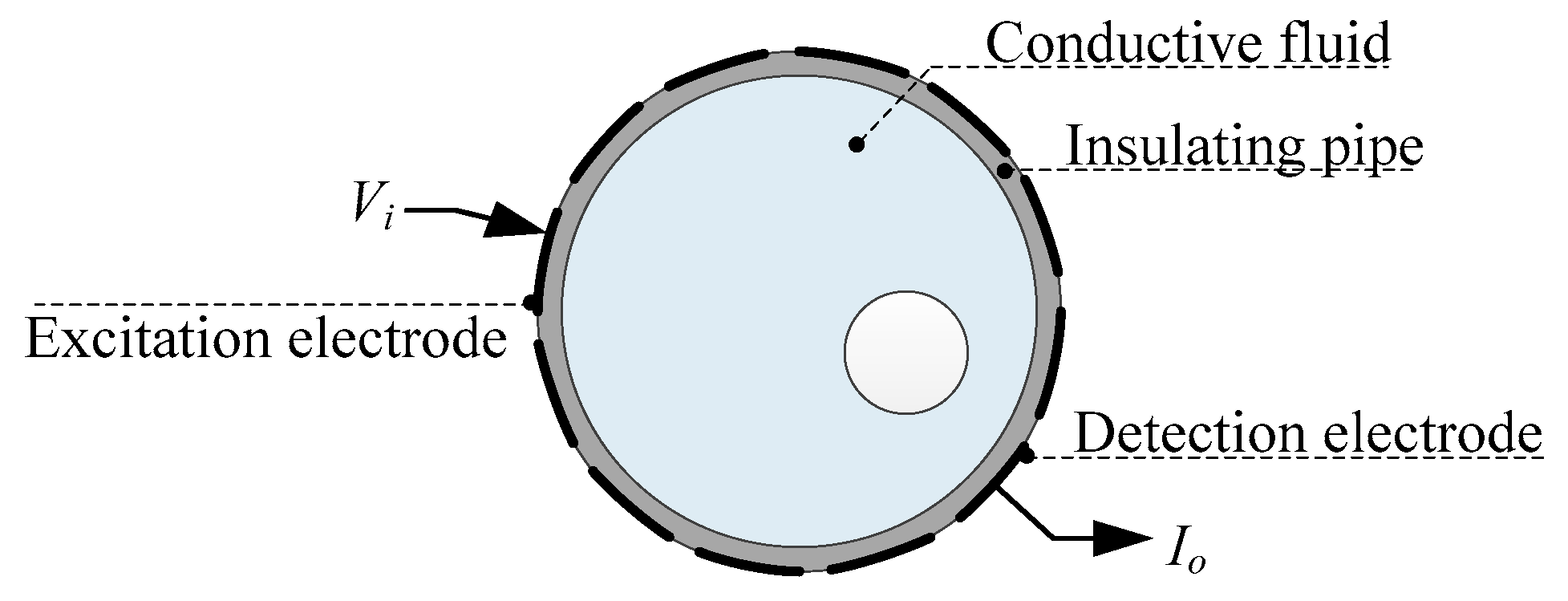
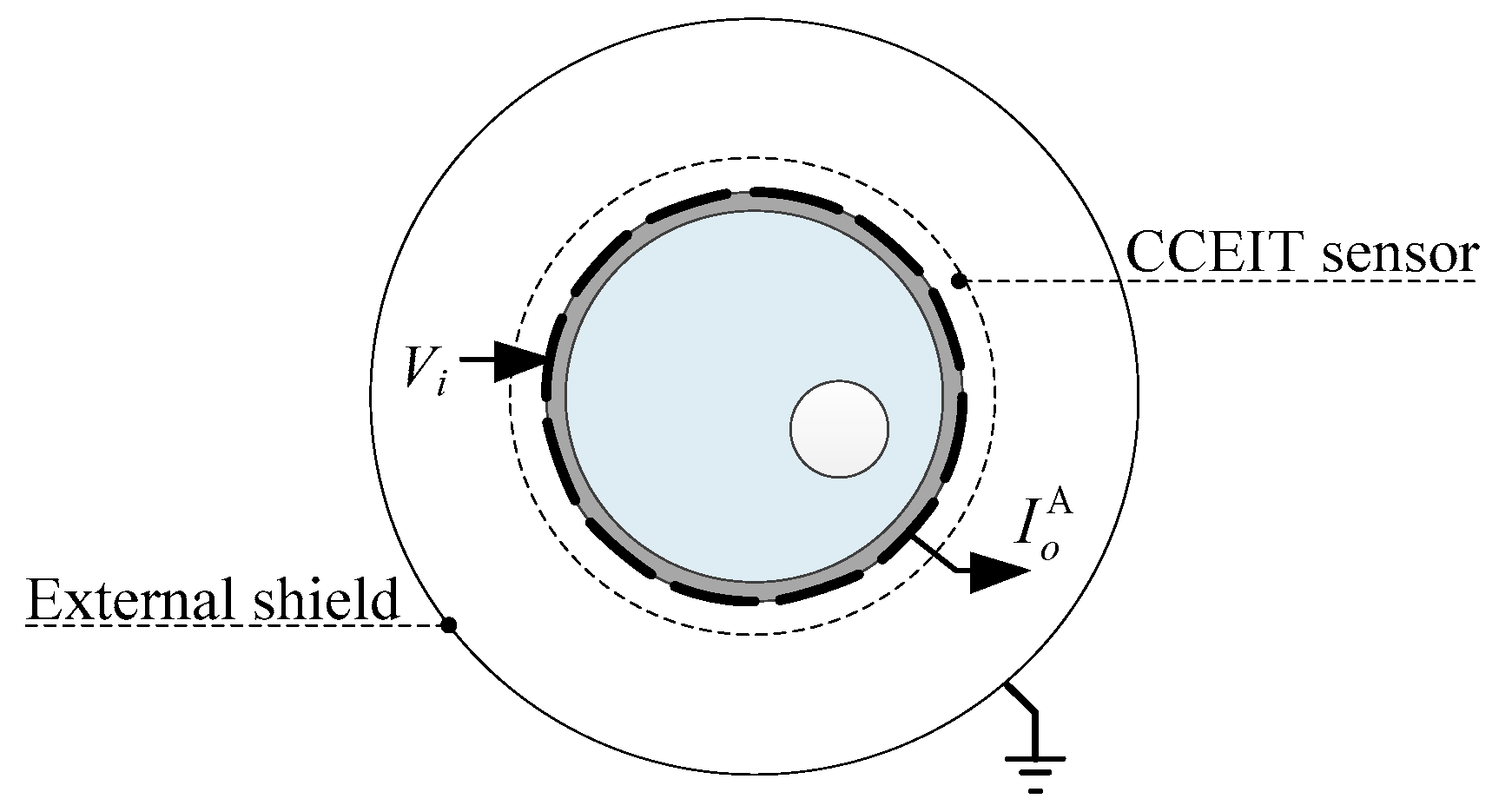
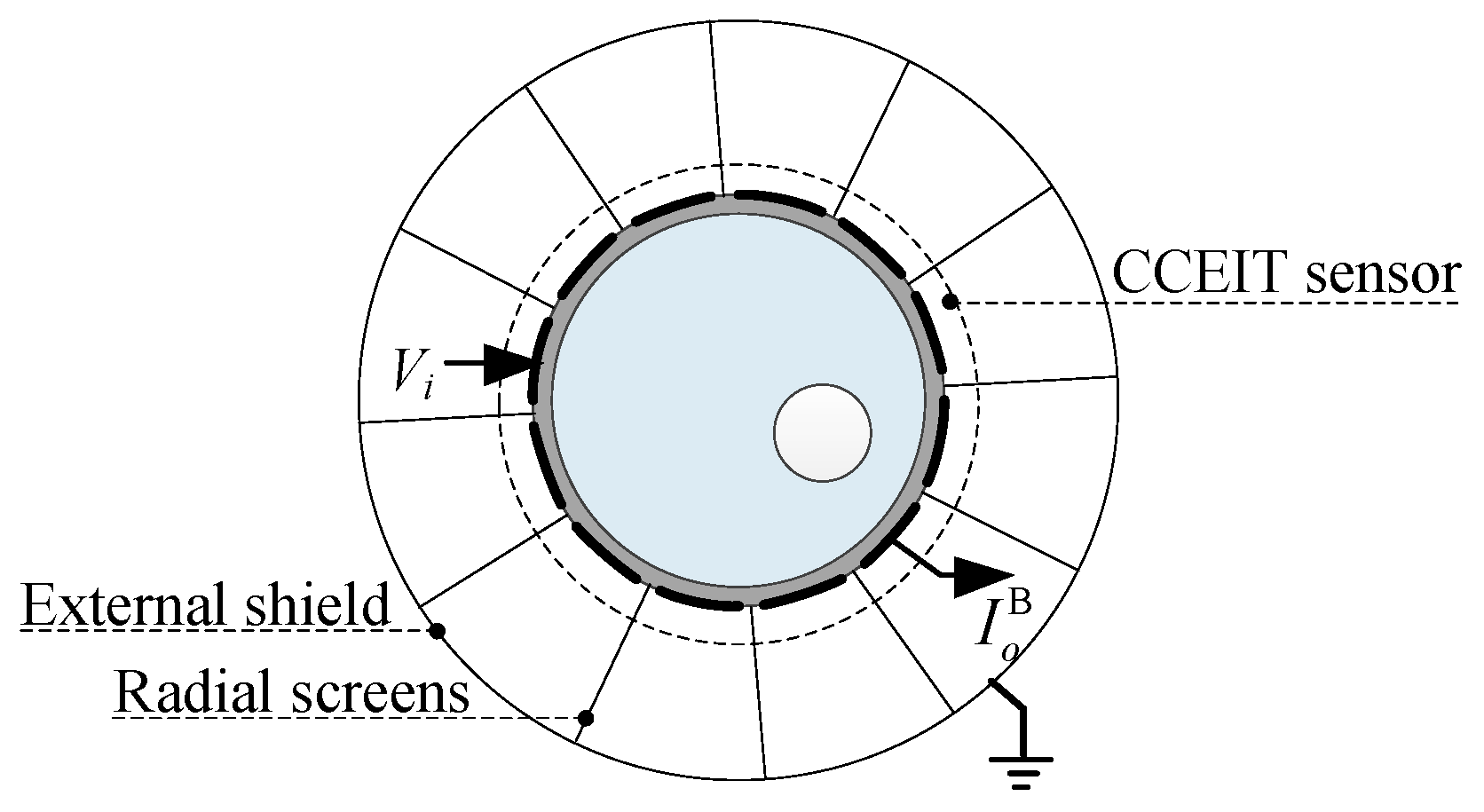
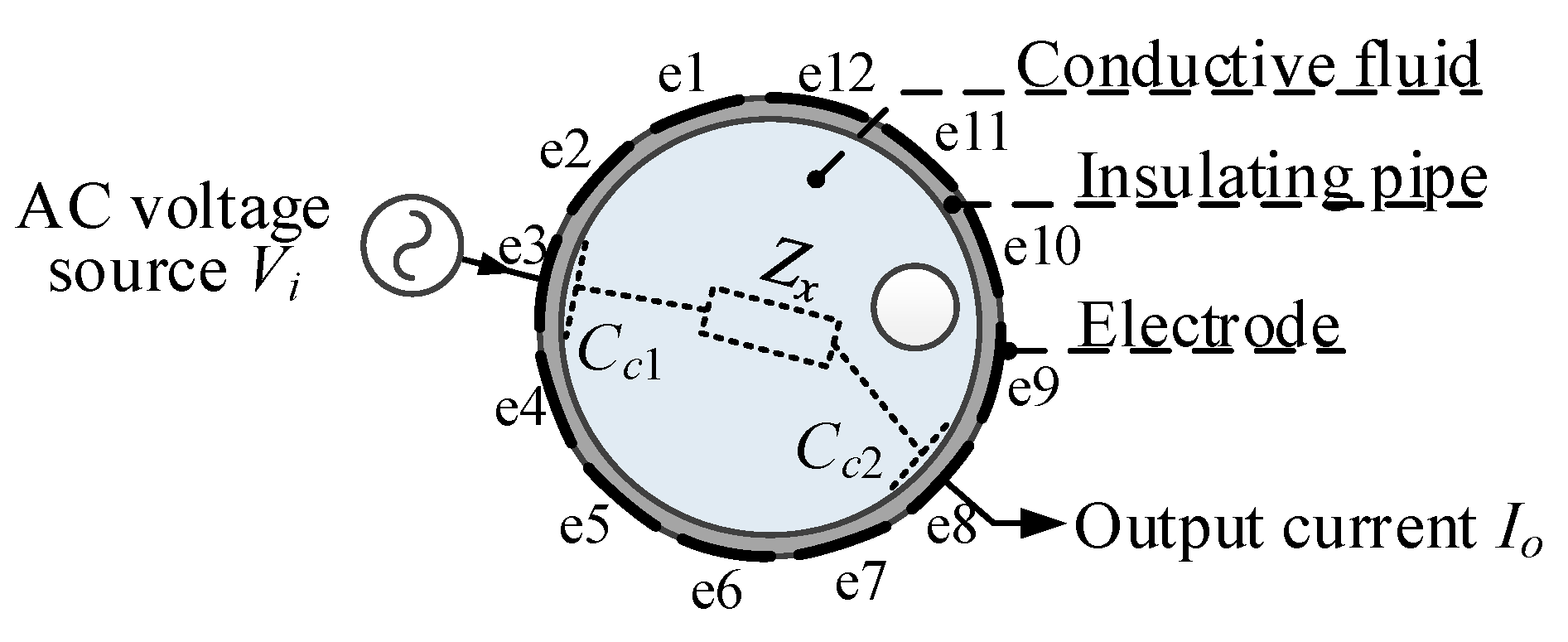



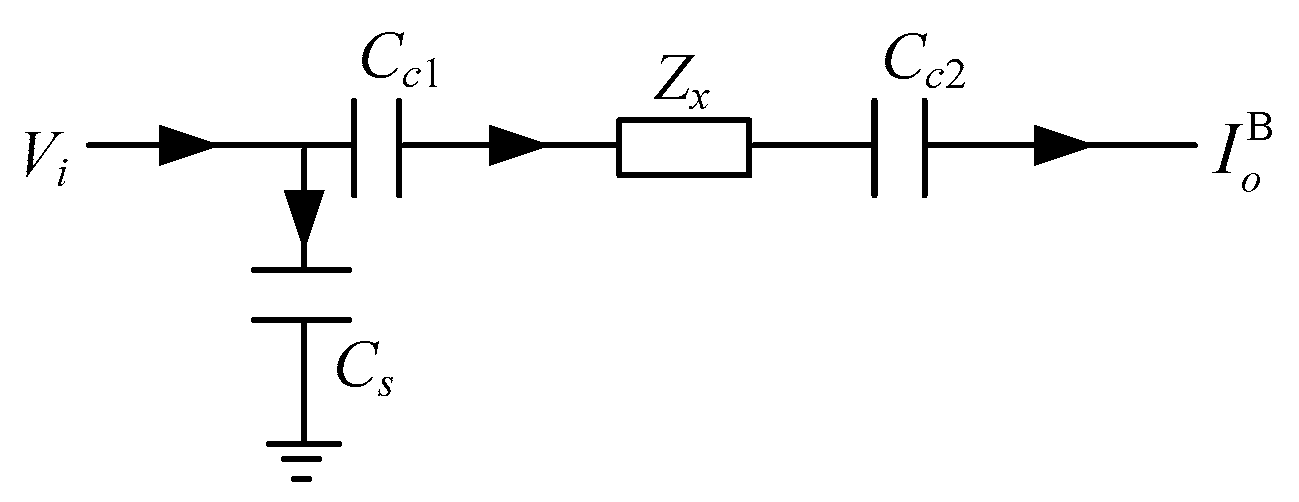
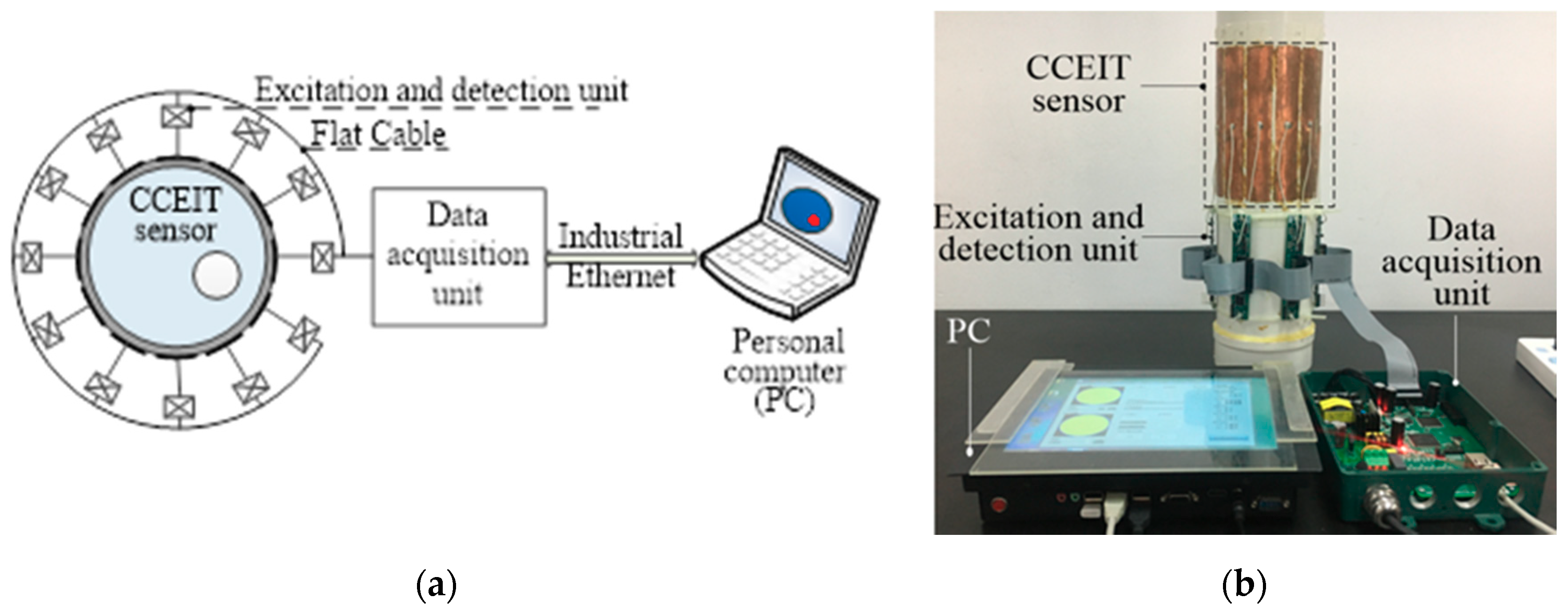


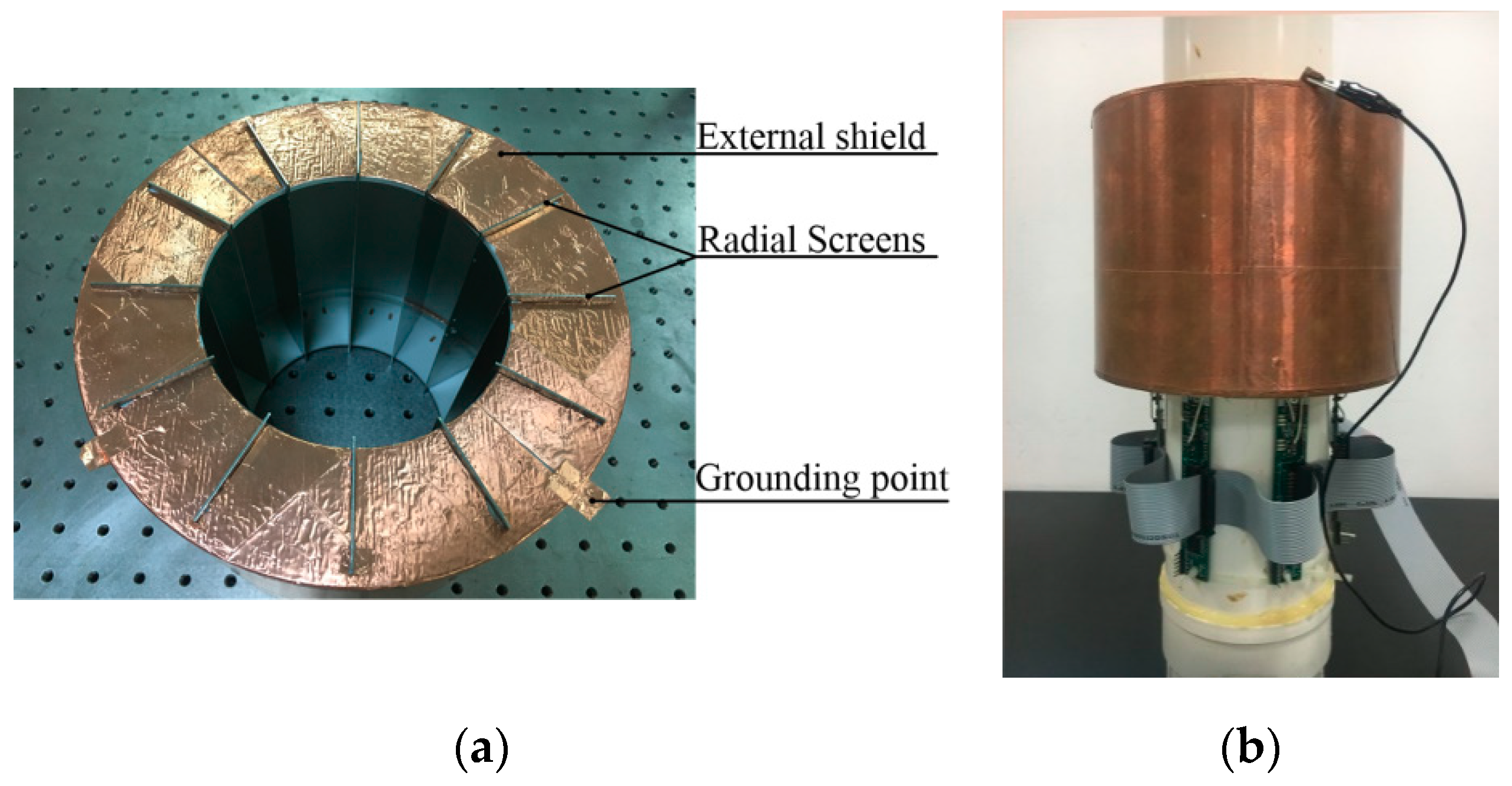
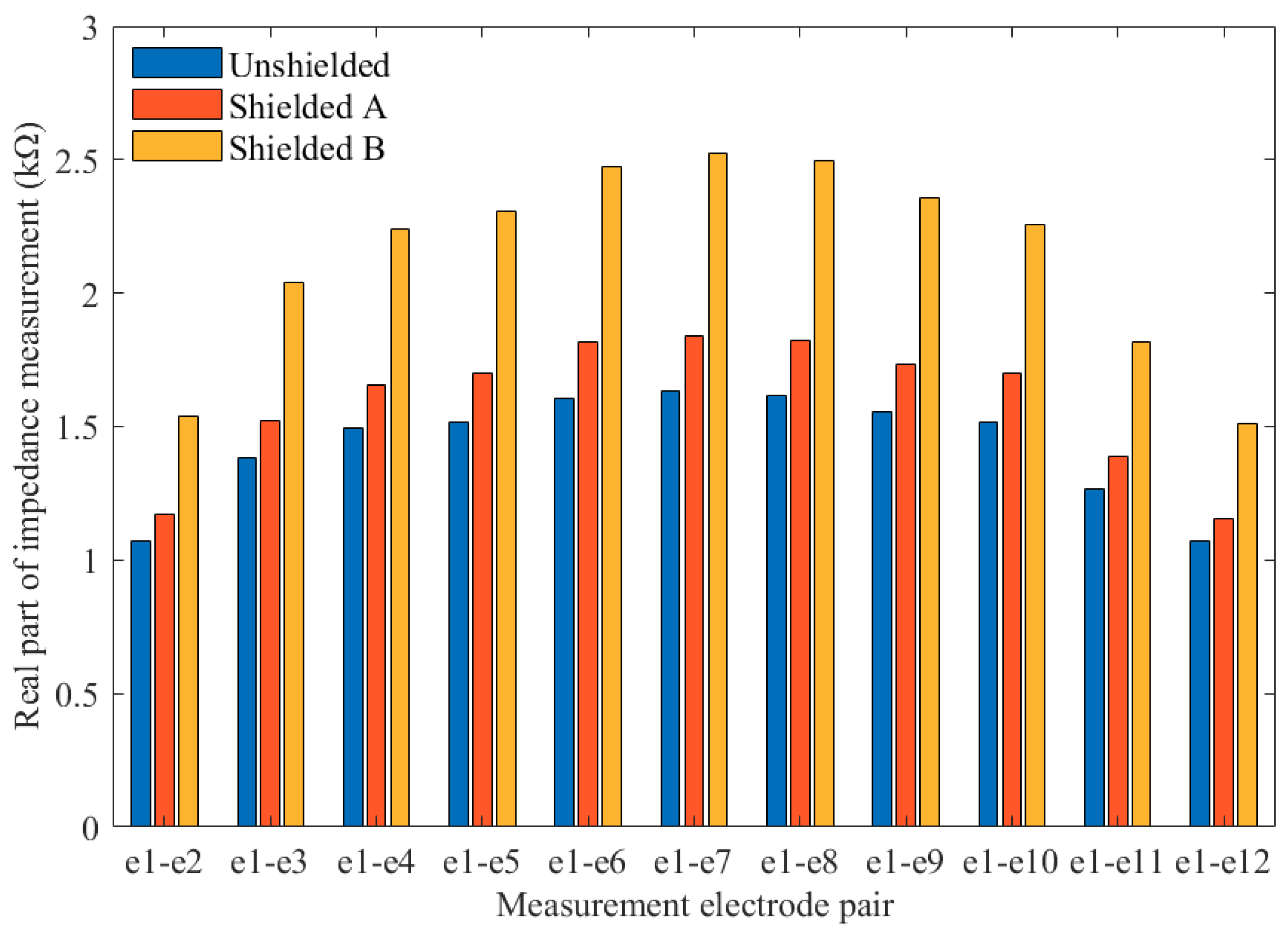
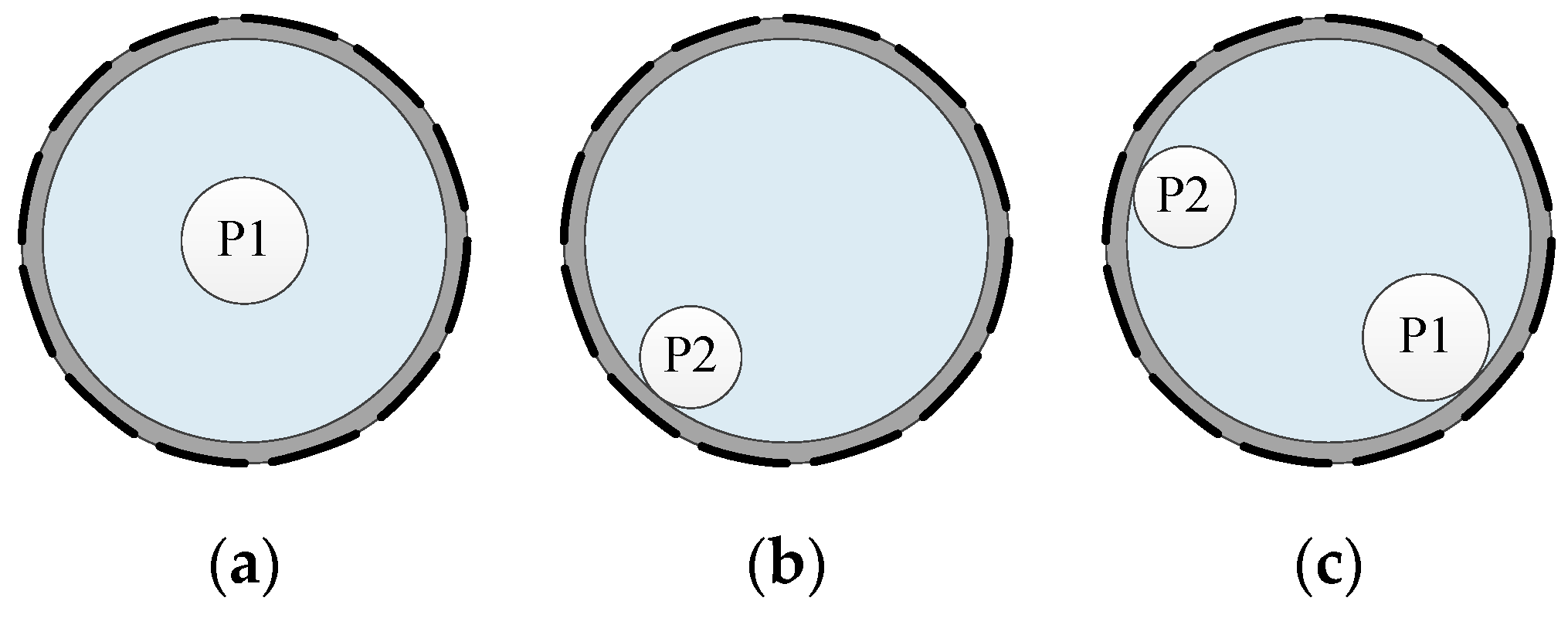
| Configuration | 2D Plot | 3D Plot | |||
|---|---|---|---|---|---|
| e1–e2 | e1–e3 | … | e1–e7 | ||
| Unshielded | 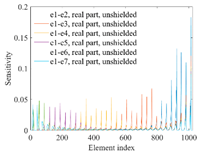 | 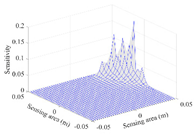 | 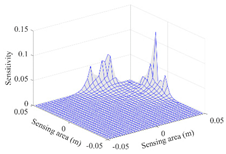 | … |  |
| Shielded A | 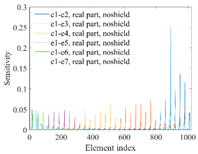 |  | 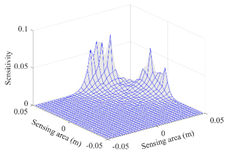 | … |  |
| Shielded B |  |  | 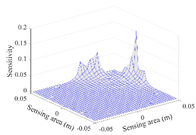 | … |  |
| Configuration | 2D Plot | 3D Plot | |||
|---|---|---|---|---|---|
| e1–e2 | e1–e3 | … | e1–e7 | ||
| Unshielded | 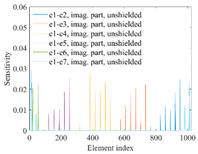 | 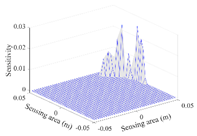 | 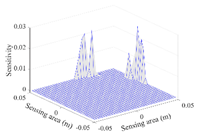 | … | 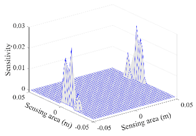 |
| Shielded A | 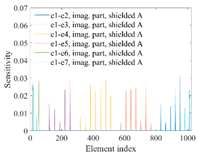 | 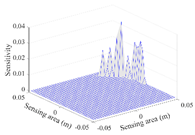 | 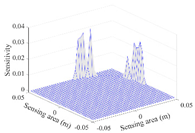 | … | 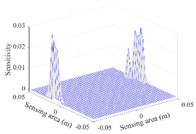 |
| Shielded B |  |  | 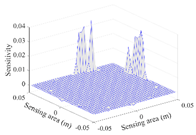 | … | 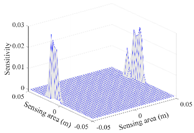 |
| Configuration | 2D Plot | 3D Plot | |||
|---|---|---|---|---|---|
| e1–e2 | e1–e3 | … | e1–e7 | ||
| Unshielded | 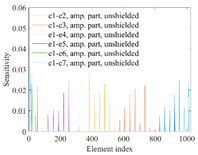 | 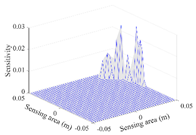 |  | … |  |
| Shielded A |  | 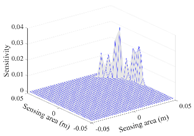 | 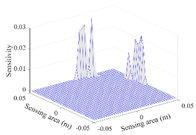 | … |  |
| Shielded B |  |  |  | … | 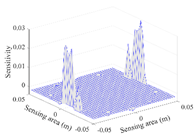 |
| Configuration | The Real Part | The Imaginary Part | The Amplitude | ||||||
|---|---|---|---|---|---|---|---|---|---|
| Sa | Su | Sf | Sa | Su | Sf | Sa | Su | Sf | |
| Unshielded | 0.00240 | 2.78434 | 1.23761 | 0.00021 | 8.98697 | 0.20766 | 0.00021 | 8.90382 | 0.20854 |
| Shielded A | 0.00236 | 2.72383 | 1.24445 | 0.00027 | 8.66250 | 0.26497 | 0.00024 | 8.92217 | 0.23670 |
| Shielded B | 0.00252 | 3.59691 | 1.72335 | 0.00028 | 9.69043 | 0.32962 | 0.00069 | 6.26585 | 0.36717 |
| CCEIT Sensor | Impedance Ratio |
|---|---|
| Unshielded | 1.5182 |
| Shielded A | 1.5682 |
| Shielded B | 1.5977 |
| Configuration | The Real Part | The Imaginary Part | The Amplitude | |
|---|---|---|---|---|
| Unshielded |  |  |  |  |
| Shielded A |  |  |  | |
| Shielded B |  |  |  |
| Configuration | The Real Part | The Imaginary Part | The Amplitude | |
|---|---|---|---|---|
| Unshielded |  |  |  |  |
| Shielded A |  |  |  | |
| Shielded B |  |  |  |
| Configuration | The Real Part | The Imaginary Part | The Amplitude | |
|---|---|---|---|---|
| Unshielded |  |  |  |  |
| Shielded A |  |  |  | |
| Shielded B |  |  |  |
| Configuration | The Real Part | The Imaginary Part | The Amplitude | ||||||
|---|---|---|---|---|---|---|---|---|---|
| S1 | S2 | S3 | S1 | S2 | S3 | S1 | S2 | S3 | |
| Unshielded | 0.5708 | 0.2259 | 0.3757 | 0.5211 | 0.3789 | 0.4706 | 0.7309 | 0.6593 | 0.6896 |
| Shielded A | 0.5300 | 0.2708 | 0.3568 | 0.4879 | 0.3344 | 0.3674 | 0.6815 | 0.3537 | 0.5990 |
| Shielded B | 0.5679 | 0.3078 | 0.3436 | 0.5481 | 0.2727 | 0.3471 | 0.7058 | 0.6516 | 0.7146 |
© 2020 by the authors. Licensee MDPI, Basel, Switzerland. This article is an open access article distributed under the terms and conditions of the Creative Commons Attribution (CC BY) license (http://creativecommons.org/licenses/by/4.0/).
Share and Cite
Jiang, Y.; He, X.; Wang, B.; Huang, Z.; Soleimani, M. On the Performance of a Capacitively Coupled Electrical Impedance Tomography Sensor with Different Configurations. Sensors 2020, 20, 5787. https://doi.org/10.3390/s20205787
Jiang Y, He X, Wang B, Huang Z, Soleimani M. On the Performance of a Capacitively Coupled Electrical Impedance Tomography Sensor with Different Configurations. Sensors. 2020; 20(20):5787. https://doi.org/10.3390/s20205787
Chicago/Turabian StyleJiang, Yandan, Xuekai He, Baoliang Wang, Zhiyao Huang, and Manuchehr Soleimani. 2020. "On the Performance of a Capacitively Coupled Electrical Impedance Tomography Sensor with Different Configurations" Sensors 20, no. 20: 5787. https://doi.org/10.3390/s20205787





